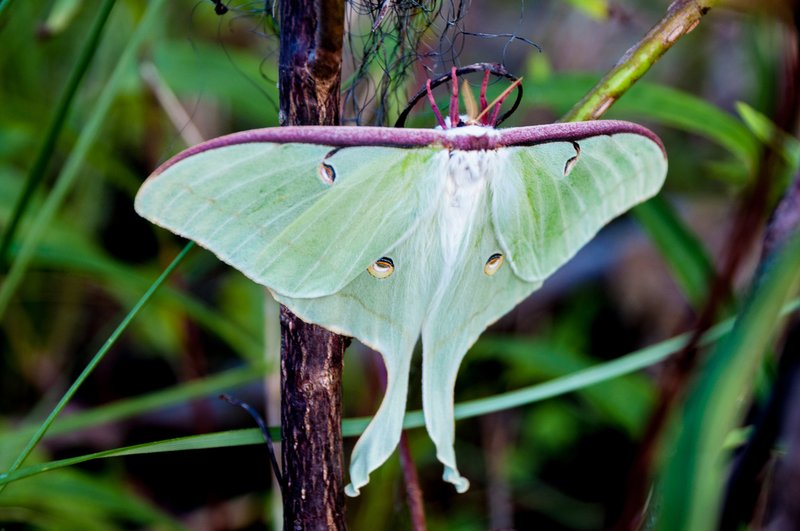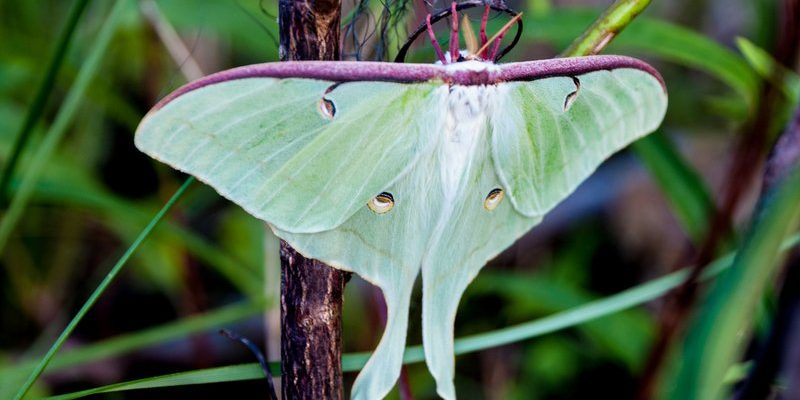
In this article, we’re diving into ten incredible facts about the Luna moth that will make you appreciate this remarkable insect even more. Whether you’re an insect enthusiast or just curious about nature’s wonders, you’ll find something intriguing here. So, let’s explore what makes the Luna moth such a fascinating creature!
1. The Luna Moth’s Appearance
You might be wondering what sets the Luna moth apart from other moths. For starters, its wingspan can reach up to 4.5 inches, making it one of the largest moths in North America. The wings are a beautiful shade of pale green, almost like they’ve been dipped in fresh spring leaves. This vibrant color helps them blend seamlessly into their natural habitat, providing some camouflage against predators.
What’s even cooler are the eyespots on its wings. Each wing has two distinct eyespots that look like little eyes, which may fool predators into thinking they’re looking at something much larger and scarier. Imagine having built-in protection that makes you look like a fierce creature even when you’re actually quite delicate!
2. Their Life Cycle is Unique
The life cycle of a Luna moth is quite different from many creatures you may know. They go through a transformation process called complete metamorphosis, which includes four stages: egg, larva (caterpillar), pupa (chrysalis), and adult. The female lays her eggs on the leaves of trees, typically in the late spring.
When the eggs hatch, the caterpillars emerge and begin munching on leaves to grow. They can consume quite a bit of foliage! After a while, the caterpillar forms a chrysalis, where it will undergo an incredible transformation into the stunning adult moth. This process can take several weeks, depending on environmental conditions like temperature and food availability.
3. Short Adult Lifespan
You might think with a creature as beautiful as the Luna moth, it would last a long time. Surprisingly, adult Luna moths typically live for only about one week. Their main focus during this brief time is to mate and lay eggs, completing the cycle of life. Isn’t it fascinating how much they have to accomplish in such a short period?
The short lifespan is a trade-off for having such magnificent wings. Unlike butterflies, Luna moths don’t feed as adults, so they don’t need to waste time looking for food. Instead, they rely on their stored energy from their caterpillar stage. This means once they emerge as adults, they are fully focused on finding a mate and ensuring their species continues.
4. They Are Nocturnal
Luna moths are primarily nocturnal, which means they are most active at night. You may have seen them fluttering around lights during a warm summer evening—this is a common sight. Their nocturnal habits help them avoid many daytime predators and take advantage of the cooler nighttime temperatures.
Being active at night also plays into their mating behaviors. Males can detect the pheromones released by females from miles away, which really helps in finding a mate in the dark. Imagine a romantic rendezvous under the stars, where the scent of the female moth guides the male through the night!
5. Habitat and Distribution
Luna moths are found throughout North America, but their presence can vary depending on the region. They prefer wooded areas with plenty of trees, as these locations provide both food and shelter. You can often find them around oak, hickory, sweet gum, and walnut trees, where their caterpillars can munch on the leaves.
In terms of climate, they thrive in warmer regions. They usually emerge in late spring or early summer when temperatures rise, making it easier for them to find mates and suitable foliage for their larvae. Next time you’re out in nature during those warm months, keep your eyes open—you just might spot a Luna moth!
6. The Role of Luna Moths in the Ecosystem
Luna moths play several important roles in their environments, and understanding this helps us appreciate their existence even more. As larvae, they are food for a variety of birds and other predators, which helps balance the ecosystem. Adult Luna moths, though they don’t feed, provide a significant food source for bats and other nocturnal creatures because of their large size.
Additionally, Luna moths are pollinators. While they’re not as efficient as bees, they still contribute to the pollination of certain plants by transferring pollen as they flutter from flower to flower at night. This shows just how interconnected our ecosystems are and how even the smallest creatures can contribute to the health of our environment.
7. Mating and Reproduction Secrets
When it comes to reproduction, Luna moths have some interesting tricks up their sleeves. The males are often larger than females, and they usually begin their search for a mate during the night. Once they find a female, they engage in a delicate courtship dance that encourages mating.
The female typically lays anywhere from 100 to 300 eggs, usually on the underside of leaves to protect them from predators. This high number ensures that even if a large number of eggs are eaten or fail to hatch, some will still survive. It’s a fascinating strategy for ensuring the continuation of the species in the wild!
8. Cultural Significance
Luna moths aren’t just pretty faces; they hold cultural significance in various contexts. In some Native American cultures, the Luna moth is regarded as a symbol of transformation and change due to its remarkable metamorphosis. This can resonate deeply, as many people view their life journeys in a similar light.
In art and literature, the stunning appearance of the Luna moth often serves as inspiration. Artists and writers have often used its beauty to represent themes of mystery, the unknown, or even fleeting beauty. It’s intriguing how a simple insect can carry such symbolic weight in human culture.
9. Conservation Status
While Luna moths are not currently considered endangered, their numbers can be affected by habitat loss due to deforestation and urban development. This makes protecting their natural habitats crucial. As environments change, conservation efforts become increasingly important to ensure these magnificent creatures continue to thrive.
You can help by creating a welcoming environment in your backyard or community garden. Planting native trees and flowers can provide food and shelter for Luna moths as well as other beneficial insects. It’s a small step that can make a big difference in their survival.
10. Fascinating Myths and Legends
Throughout history, many myths and legends have been woven around the Luna moth. In some cultures, they are seen as messengers from the spirit world, bridging the gap between the living and the deceased. This spiritual association adds an enchanting element to the already mystical allure of these moths.
Others believe that seeing a Luna moth can bring good luck or signify change is on the horizon. The way these gentle creatures flutter through the night can evoke a sense of wonder, making them a beautiful reminder of life’s mysteries and surprises.
In conclusion, the Luna moth is more than just a pretty insect; it’s a vital part of our ecosystem that tells an exciting story of life, transformation, and beauty. Next time you see one fluttering by, take a moment to appreciate all the incredible things we’ve explored together. Nature’s wonders never cease to amaze, do they?

